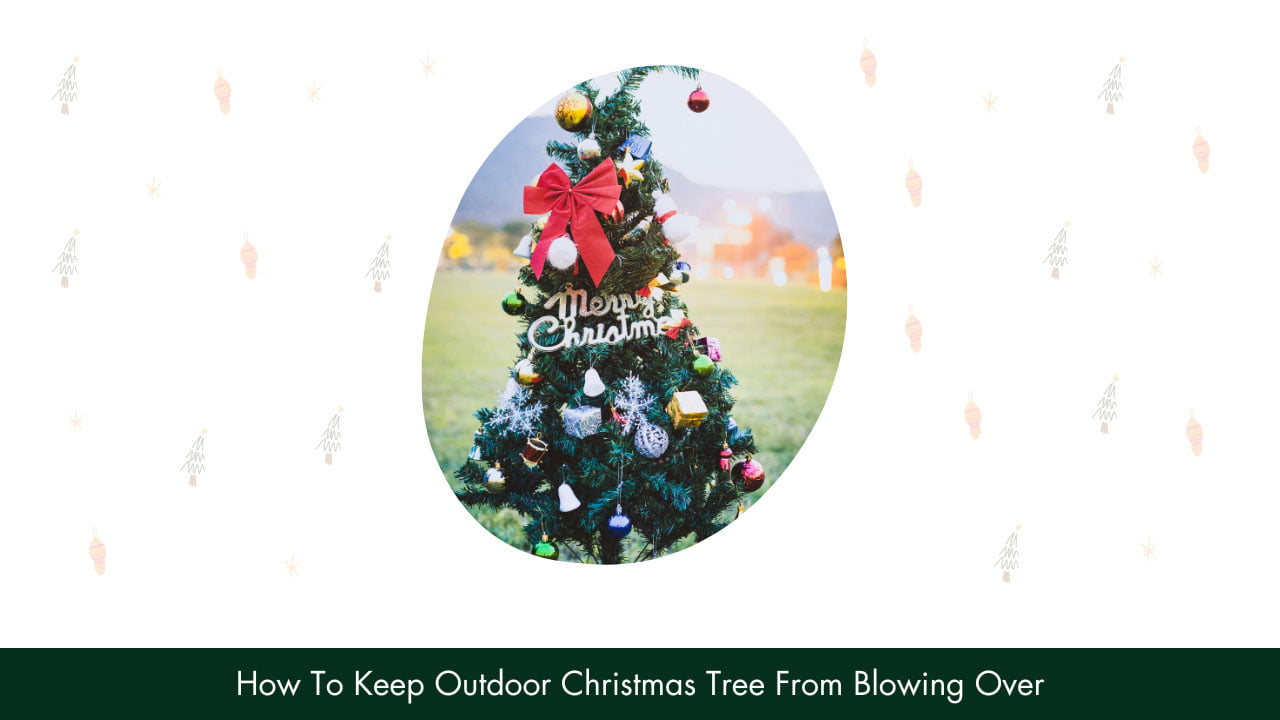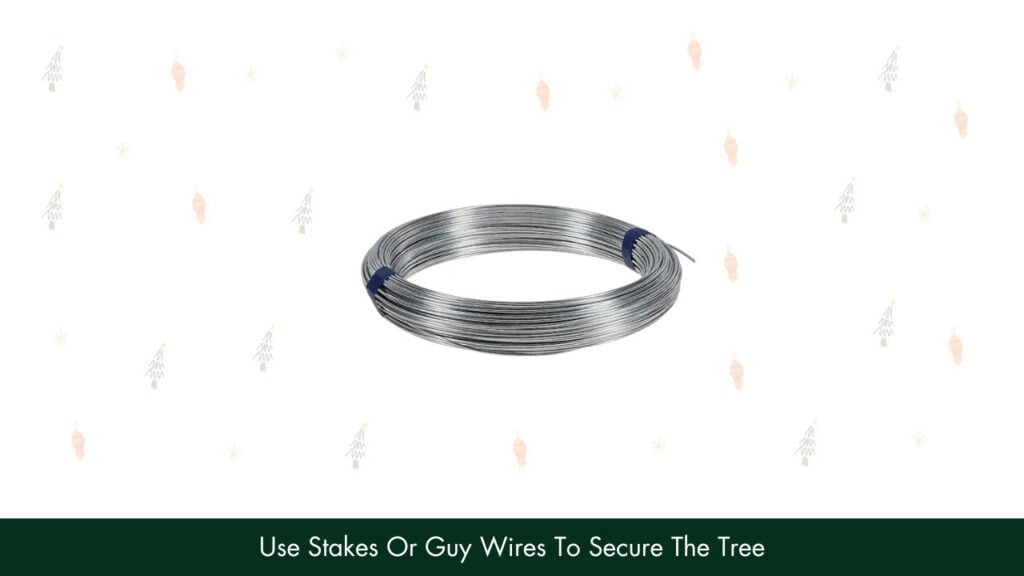Outdoor Christmas trees can be stopped from blowing over through various means, like planning the tree’s location to securing it in its position. Keeping the tree as stationary as possible without it toppling over will help it remain pristine and gorgeous throughout the holiday season.

Artificial or natural, Christmas trees tend to fall over during strong winds, which can become frustrating very quickly.
And Christmas celebrations are smack-dab in the middle of the winter season, which means that you will see your tree topple very frequently. Of course, stopping this from happening will keep your tree looking just as good as it did the day you set it up.
So, here’s a guide to preventing trees from blowing over and sustaining unnecessary damage.
How to Keep Outdoor Christmas Trees From Falling Over
Winter winds can be very strong, and depending on where you live, they can be downright tempestuous. This makes the problem of fallen Christmas trees a difficult one to solve, particularly since it can damage both the tree and the Christmas decoration. After all, replacing broken ornaments and mending damaged tree branches can become a nightmare to deal with throughout the holidays.
If you’ve had prior experience with this issue, you may have already figured out what has to be done to solve it. The gist of it is to keep the tree stationary so no gust of wind is strong enough to knock your tree down. Of course, the difficulty of the problem lies with the approach rather than the immediate solution.
So, here’s what you can do to keep your outside Christmas tree from falling over in the winter winds:
- Position your tree in the right spot
- Use wires and stakes to secure the tree
- Make use of heavy outdoor Christmas décor and tree ornaments
- Get the right tree stand with a wide base
1. Picking The Right Location

Positioning your tree well can very well be the difference between a gorgeous, fully intact Christmas tree and a damaged, unsightly one.
One of the best ways to keep the tree from toppling over is to keep it in a sheltered location. By doing so, you will be limiting the chances of it facing strong gusts of wind, keeping it safe from any potential damage. Additionally, there will be no need to move it for the remainder of the Christmas and holiday season, making the decorative process a one-time task.
Places like the front porch or the patio provide ample shelter for the tree while making it the focal point of your home. The aesthetics of your home will be preserved while the tree remains safe from the elements.
Another great place to set up a Christmas tree for holiday-themed aesthetics is the yard. Of course, most yards are open and lack any surrounding structures to shield the tree, creating a few problems for the Christmas décor. That said, this can be worked around without any issues.
You can look at the weather forecasts and keep track of the wind direction using wind devices. Consider placing the tree next to your backyard shed or the house itself, based on the wind direction. That way, you will be able to shield the house quite easily without having to worry about the tree falling over constantly.
Thus, it all comes down to the wind direction and how you position the tree in relation to the nearby buildings and sheds.
2. Use Stakes Or Guy Wires To Secure The Tree

Unfortunately, there is a chance that the wind direction is simply not favorable for your Christmas tree. And if there are no surrounding structures to block the wind, the tree being knocked over by strong wind seems inevitable.
In such an event, you can use the simplest of all solutions: tie the tree down. While this can be somewhat difficult to hide, especially if your tree is large, it is a solution that won’t make an unsightly mess.
Securing the tree with stakes or guy wires is simple. To do so, you’ll only need a set of guy wires or ropes, stakes or tent spikes, and a large hammer. Simply follow the steps detailed below to wire your tree easily.
Step 1: Fasten A Guy Wire Or Rope Around The Tree Trunk
After sizing the tree properly, fasten a guy wire around the trunk as tightly as you can. Ensure that the knot doesn’t come off by tugging on it lightly, after which you may proceed to tie the wire to a stake.
Step 2: Tie The Rope To A Tent Spike, Stake, Or A Baluster
Tie the wire or rope to a stake, tent spike, or porch baluster based on what you have available close to the tree. If you’re using either of the first two, note that you must ensure the tent spike has been driven far enough into the ground. You’ll want the spike or stake to act as the anchor for the duration of the holiday season, after all.
An important thing to note with regard to balusters is that they need to be strong enough to hold the weight of your tree. There have been a few cases where the balusters snapped in half under duress, which can be a headache to mend. While not the best solution, balusters can be a decent option if tent spikes or stakes aren’t available.
Step 3: Repeat The Steps For Several Stakes Or Tent Spikes
Set up a few other tying spots to make sure the weight of the tree is distributed among multiple tent pegs or balusters. Additionally, it’s usually best to arrange the tying spots in a circular pattern. That way, your tree will have enough support not to topple over in any direction.
And lastly, ensure that the stake-and-guy-wire setup isn’t a tripping hazard in your front lawn or backyard. An accidental tripping can easily undo all your hard work with the tree, which can put a damper on your festivities very quickly. So, it’s for the best not to space the stakes out more than a foot from the tree.
3. Use Heavier Christmas Decorations And Ornaments

If you’re looking to immobilize your tree, why not weigh it down to the point that it cannot move freely at all?
Using heavy ornaments and larger decorations can achieve just that, with their addition increasing the overall weight of the tree. And with an appropriate amount of Christmas decorations fastened to the tree branches, the tree will have enough mass to withstand strong gusts.
Advise
This only applies to larger trees since the branches of smaller trees would simply break under the weight. At most, you can hang a couple of baubles and garlands on the smaller trees before they deform or snap.
So, once you’ve gathered your hanging decorations and ornaments, try to make sure that the tree branches are thick enough not to be easily damaged. Natural trees like white spruce and Fraser Firs can easily handle heavy items, while you will require a wide and large artificial Christmas tree for the same purpose.
Tip
Try not to crush the short needles of white spruce, as it can spread an unpleasant odor around the environment. It’s better to be cautious when decorating this tree.
Baubles can be affixed to an outdoor tree using twist cable ties that allow you to attach each ornament to the branches. Tie them well enough, and they will not budge in the winter winds. And make sure you place several of these spherical ornaments all around the outdoor tree to spread the weight around equally.
Pair these with inflatable decorations, decorations made with paper and ribbons and string lights for a complete Christmassy feel. Do note that Christmas inflatables might not withstand a windy night, so feel free to take them down before you call it a night.
4. Pick A Tree With A Wide Base
The wider the tree base, the more difficult it will be for anything to knock it over. That includes wind as well.
By increasing the surface area of the tree base, you can effectively give the tree a solid foundation that keeps it still no matter what. The increased stability is good, but the wider base can practically make the natural or artificial tree immovable if you add weights to it.
Wondering how? It’s as simple as filling up small plastic store bags with rocks or sand and placing them over the base. That is all there is to improve the stability of your Christmas tree.
For smaller trees, even an outdoor umbrella stand can work well enough as a Christmas tree base. All you need to do is make sure that the pipe diameter of the umbrella stand is wide enough to accommodate the tree trunk. Once that is done, you can weigh it down using a sandbag or tie straps to reinforce its stability further.
What if you had a larger tree? If so, you can use a metal fence post base instead that is functionally the same as an umbrella stand. The only extra step with a metal fence post base is that you will need to affix the base to the location of your Christmas tree. For decking and patio, you may need to drill holes into the deck or the concrete floor to secure the base as well.
Lastly, if you live in a particularly windy area, you can combine all the methods listed here to make your Christmas tree immune to wind. Your tree will stand tall when faced with anything that isn’t a heavy storm.
Can I use a regular tree stand for an outdoor Christmas tree?
You may be able to do so, provided that you remain vigilant of certain factors. To use a regular tree stand for an outside Christmas tree, you must abide by one of the following conditions:
- Live in an area that doesn’t face high-speed winds
- Shelter the natural or artificial tree well
- Use guy wires or tie straps to secure the tree completely
- Use heavy ornaments to weigh the tree down
A wider tree stand is better than a regular one in almost all scenarios, so consider switching to one as it is a convenient solution.
How do I maintain an outdoor Christmas tree during windy weather?
Caring for a Christmas tree can be challenging, especially if your tree is a natural one. A natural tree needs up to a gallon of water every day to appear fresh and vibrant, something artificial trees don’t need at all.
Here are a few tips to take care of your tree during bad weather conditions:
- Before decorating, keep the tree sheltered in a cool porch or patio
- Cut cleanly across the bottom of its trunk
- Use LED lights for both artificial and natural trees for low heat exposure
- Consider recycling the tree after the holidays are over
- Check the water level of your tree every day
An evergreen tree can last several weeks with proper care and can be recycled for further use. Usually, this can be done through local Christmas tree recycling programs.
But if it dries up completely, or if your fake tree can’t be repaired, you may want to dispose of the Christmas tree.
Can I use a fake tree outdoors?
Artificial trees can be used outside safely, provided that they are designed for it. Some material types, like textiles and plastics, can’t withstand direct solar, rain, and wind exposure, causing them to fade over time. On the other hand, even prelit trees can be used outdoors, depending on the make.
Consider the manufacturer’s recommendations before purchasing an artificial Christmas tree for outdoor use.
As a temporary solution, you can make your tree fade-resistant by using a UV-resistant spray. You can find these on the market based on the materials used to make the plant.
Final Words
Outdoor Christmas trees can be prone to blowing over in windy weather, which is why you should provide them with ample support. After all, there’s no better way to ensure that your festive spirits remain high all holiday long than a vibrant Christmas tree standing tall.
No matter what kind of Christmas tree you choose, it’s always good to take precautionary measures to keep it upright. The methods listed in this guide, along with DIY methods like weight bags, will help prevent the tree from falling over.
And lastly, don’t forget to take good care of your natural Christmas tree! It needs as much care as any other plant, requiring plenty of water and gardening care before it’s ready for you to decorate. With that, your tree will be the brightest beacon of your home throughout the Christmas season, bar none.
